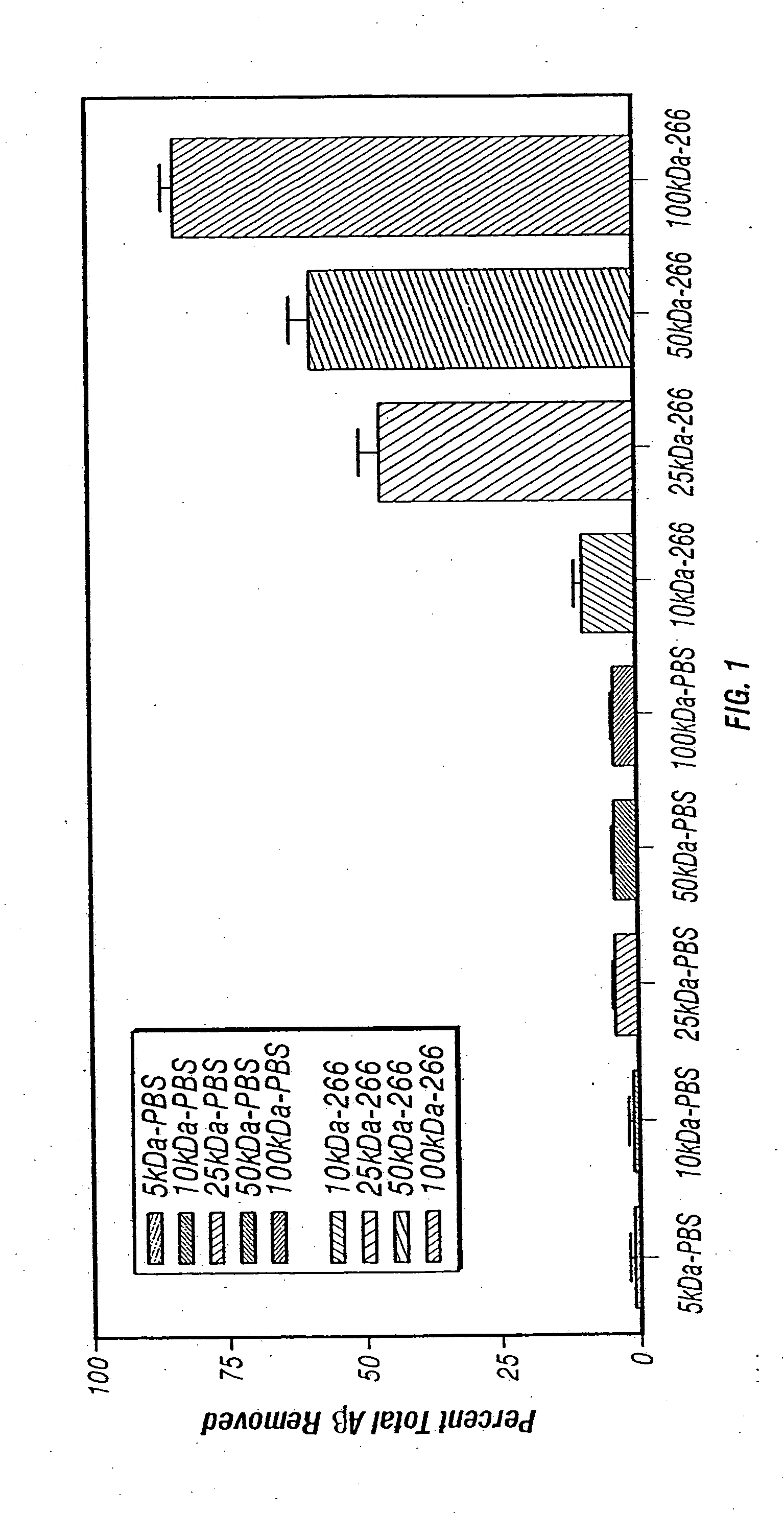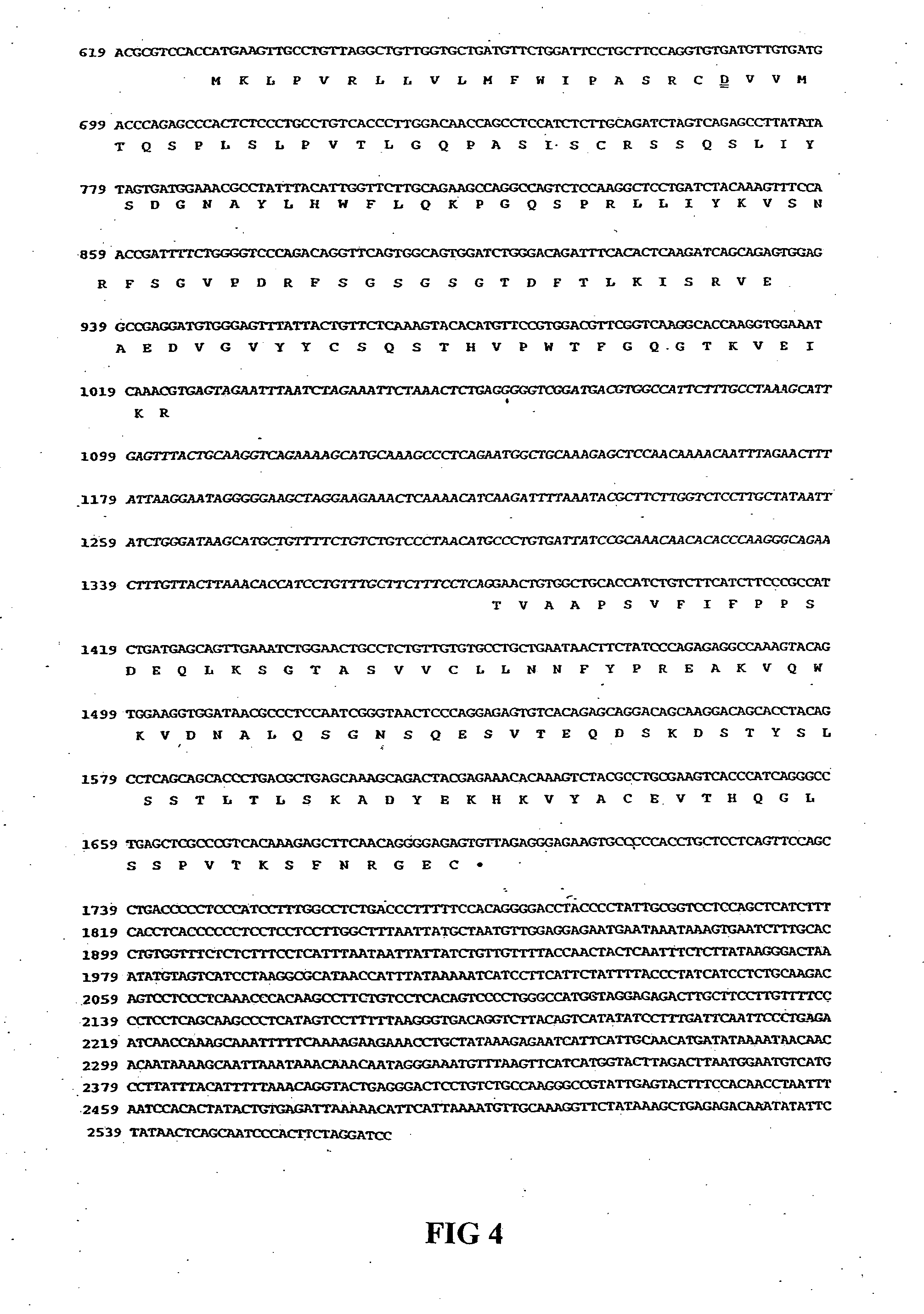Humanized antibodies that sequester abeta peptide
a technology of humanized antibodies and abeta peptides, which is applied in the field of humanized antibodies, can solve the problems of antibody not having the properties, interfere with plaque formation, and reduce plaque burden, and achieve the effects of inhibiting the toxic effects of soluble a, enhancing the net efflux from the brain, and enhancing the removal of the body
- Summary
- Abstract
- Description
- Claims
- Application Information
AI Technical Summary
Benefits of technology
Problems solved by technology
Method used
Image
Examples
example 1
Sequestration of Added Aβ Peptide in Human Fluids
[0098] Samples of human cerebrospinal fluid (CSF) (50 μl) and human plasma (50 μl) were incubated for 1 hour at room temperature as follows: [0099] 1. alone; [0100] 2. along with 5 ng Aβ 40 peptide; or [0101] 3. 5 ng Aβ 40 peptide plus 1 mg monoclonal antibody 266 (described, for example, in U.S. Pat. No. 5,766,846 incorporated herein by reference).
[0102] The samples were then electrophoresed on a 4-25% non-denaturing gradient gel, i.e., non-denaturing gradient electrophoresis (NDGGE) and transferred to nitrocellulose. The blots were then stained with Ponceau S or, for Western blot, probed with biotin-labeled monoclonal antibody (3D6) which is directed against the first five amino acids of Aβ peptide, developed with streptavidin-horse radish peroxidase and detected by enhanced chemiluminescence (ECL). The hydrated diameters of the materials contained in bands on the blots were estimated using Pharmacia molecular weight markers. Thus...
example 2
Specificity of the Sequestering Antibody
[0104] Samples containing 50 μl of human CSF or 10 μl of APPV717F CSF were used. APPV717F are transgenic mice representing a mouse model of Alzheimer's disease in which the human amyloid precursor protein transgene with a familial Alzheimer's disease mutation is expressed and results in the production of human Aβ peptide in the central nervous system.
[0105] The samples were incubated with or without various Mabs (1 μg) for 1 hour at room temperature and then electrophoresed on a 4-25% NDGGE and blotted onto nitrocellulose as described in Example 1. The antibodies were as follows: [0106] Mab 266 (binds to positions 13-28); [0107] Mab 4G8 (binds to positions 17-24); [0108] QCBpan (rabbit polyclonal for positions 1-40); [0109] mouse IgG (non-specific); [0110] Mab 3D6 (binds to positions 1-5); [0111] Mab 21F12 (binds to positions 33-42): [0112] Mab 6E10 (binds to positions 1-17); and [0113] QCB40,42 (rabbit polyclonals to Aβ40 and Aβ42).
[0114] ...
example 3
Demonstration of Aβ Peptide—266 Complex by Two-Dimensional Electrophoresis
[0117] A sample containing 50 ng Aβ40 peptide was incubated with 2 μg Mab 266 at 37° C. for 3 hours. A corresponding incubation of Mab 266 alone was used as a control.
[0118] The samples were then subjected to 2-dimensional gel electrophoresis.
[0119] In the first dimension, the incubated samples were subjected to NDGGE as described in Example 1. The polyacrylamide gel was then cut into individual lanes perpendicular to the direction of the first dimensional flow and gel separation under denaturing / reducing conditions by SDS-PAGE (Tricine urea gel) was performed in the second dimension. The presence of the bands was detected either by Ponceau-S staining (any protein) or by specific development using 6E10 Mab (Senetek, Inc.) and biotinylated anti-mouse Aβ in the HRP-based detection system.
[0120] Ponceau-S staining of the nitrocellulose blots after transfer permitted visualization of the heavy and light chains...
PUM
| Property | Measurement | Unit |
|---|---|---|
| concentration | aaaaa | aaaaa |
| volume | aaaaa | aaaaa |
| hydrated diameter | aaaaa | aaaaa |
Abstract
Description
Claims
Application Information
 Login to View More
Login to View More - R&D
- Intellectual Property
- Life Sciences
- Materials
- Tech Scout
- Unparalleled Data Quality
- Higher Quality Content
- 60% Fewer Hallucinations
Browse by: Latest US Patents, China's latest patents, Technical Efficacy Thesaurus, Application Domain, Technology Topic, Popular Technical Reports.
© 2025 PatSnap. All rights reserved.Legal|Privacy policy|Modern Slavery Act Transparency Statement|Sitemap|About US| Contact US: help@patsnap.com



